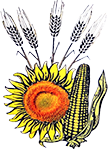The Use of Wild Sunflower Species in Breeding for Resistance/Tolerance
to Abiotic and Biotic Factors
Florin Gabriel Anton1, Maria Joiţa Păcureanu1,2, Luxiţa Rȋșnoveanu3,4, Elena Laura Conţescu1
1Institutul Național de Cercetare Dezvoltare Agricolă Fundulea
2Centrul de Studii și Cercetări de Biodiversitate Agrosilvică "Acad. David Davidescu", București
3Stațiunea de Cercetare-Dezvoltare Agricolă Brăila
4Academia de Studii Economice, Facultatea de Economie Agroalimentară și Ingineria Mediului, București
Keywords: wild species, sunflower, resistance/tolerance.
Abstract: Wild sunflower species represent an important source of valuable genes for tolerance/resistance to biotic and abiotic factors. Wild sunflower species are used for breeding cultivated sunflower (Helianthus annuus L.) and to increase genetic diversity. In the sunflower breeding program for tolerance/resistance to biotic and abiotic factors at the National Agricultural Research and Development Institute Fundulea, we used the annual wild species Helianthus debilis T&G subspecies debilis, Helianthus petiolaris, Helianthus praecox Eng&Gray subspecies praecox, Helianthus argophyllus T&G, Helianthus neglectus Heiser and the perennial wild species Helianthus decapetalus L., Helianthus divaricatus L., Helianthus giganteus L., Helianthus hirsutus Raf., Helianthus maxililiani Schrader, Helianthus mollis Lam., Helianthus strumosus L. and Helianthus tuberosus L. For resistance/drought tolerance, the best results were obtained by crossing inbred sunflower lines with the annual wild species Helianthus argophyllus and the perennial wild species Helianthus tuberosus. For resistance/tolerance to the attack of the pathogen Plasmopara halstedii (Farl) Berl. Et de Toni, the best results were obtained by crossing inbred sunflower lines with the annual wild species Helianthus debilis subspecies debilis. Molecular analyzes with SSR molecular markers ORS166 and ORS1043 revealed differences between sunflower genotypes tolerant to the pathogen Plasmopara halstedii and susceptible ones. For resistance/tolerance to the attack of the parasite Orobanche cumana Wallr., the best results were obtained by crossing inbred sunflower lines with the perennial wild species Helianthus mollis. Molecular analyzes with SSR molecular markers ORS1036, ORS1114 revealed differences between sunflower genotypes tolerant to the parasite Orobanche cumana and sensitive ones.
